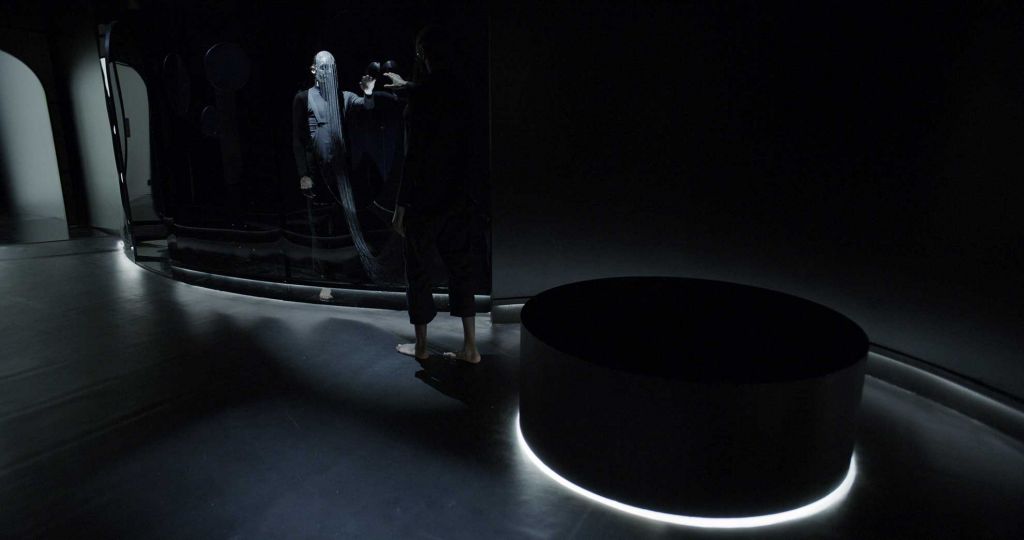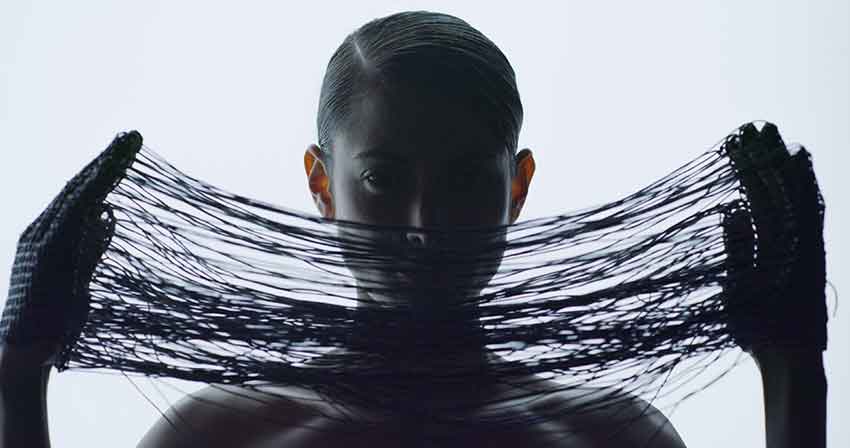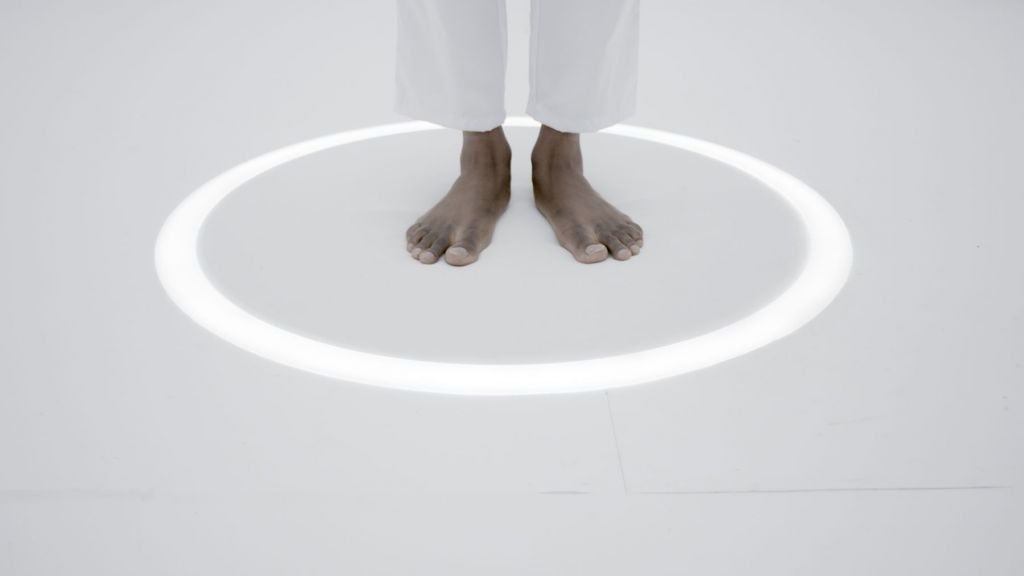Interview Agata Kik

Ania Catherine and Dejha Ti is an artist duo specialising in immersive environments. Through their experimental works, they explore the politics of performativity and the technological impact of the present day. They teleport their audiences into worlds which are digitally fabricated and constituted by affect. Producing large-scale projects as art house Operator, their output cannot be categorised, simultaneously belonging to nightlife and fine art. What unites their collaborative creation is the quality of immersion, which goes beyond the physical and delves into the virtuality of emotional sensations.
Ania Catherine, with a background in choreography and Dejha Ti, skilled in immersive experience design, last year were even called the ‘LGBT power couple’ by the press. They act in unison as the two critical contemporary voices on the digital art’s international stages. Most recently, for Madame Gandhi, they directed and co-starred in a music video with a queer love narrative. The couple is open about the fact that they met online through Instagram. Their artistic practice, thus, inevitably poses urgent questions about social media, selfie culture and human-computer interaction, highlighting control and soft power capitalised on through online data brokering.
They produced immersive performance installations in multiple organisational collaborations, including the 2018 Art Basel Hong Kong, where a wall made out of red flowers was activated by feminine arms handing out champagne glasses. At Trauma Bar und Kino art space in Berlin, for example, their durational performance installation ‘EMPTY HOUR’ was a surreal environment, where old ladies were reordering time and cocktails were ordering their guests.
One of their major projects, On View, is an interactive exhibition commissioned by the SCAD Museum of Art in 2019, highlighting the generational desire to be the subject of art experience. With their appearance reflected, the viewing subject was simultaneously the object that was gazed at. Through TouchDesigner, real-time facial recognition, machine learning, kinetics and capacitive sensors, they constructed a future-like immersive environment resembling a high-tech sterile white cube gallery. As a result, Ania and Dejha put on display ‘the often-forgotten body of the modern spectator’, as Brian O’Doherty had framed it already a couple of decades ago.
In contrast to the modern art gallery viewer of the past, whose experience was that of a physical relationship between art and their body and the bodies of other viewers, the present-day spectator, equipped with a smartphone, faces art with their back much of the viewing time, experiences the display through the screen, as a background to their fabricated presence in Internet’s virtuality.
Not only reflecting on the contemporary choreography of spectatorship and experience of a present-day museumgoer, but the project was also a re-enactment of the ways in which we engage with social media. Instead of clicking ‘Agree’ to Terms and Conditions that grant one an online presence in the gallery space, one automatically agreed to a contract with them by stepping on a designated illuminated spot with their feet. Uncertain of what they were complying with, either online or inside the gallery, the participant would agree to anything just in order to see themselves being seen.
Just like the exhibition space’s quality of performativity belongs to the audience, not only the art object, so does contemporary life outside the gallery’s entrance is a stage for a performance. The lack of difference is also an expression of the contemporary moment, on which Nigel Thrift, the founder of the non-representational theory, comments: ‘we now live in a performative world’, what contemporary digital technology makes even more apparent.
Ania Catherine and Dejha Ti, thanks to their innovative use of technology, artistic genius and critical observation of contemporaneity, manage to transport their audiences into otherworldly dimensions for them to rehearse their daily earthly affects and realise how they fuel the system of surveillance capitalism.


For our audience that is not familiar with your work, could you tell a bit more about your background and what brought you to work together?
We’re artists based in LA and have a collaborative practice integrating environments, creative technology and performance, culminating in experiences and worlds into which audiences are immersed not only physically but also emotionally. Dejha’s background is in multimedia, human and computer interaction (HCI), and immersive art, and Ania’s is in choreography and performance art; she also has a master’s in gender studies, which often feeds into our work.
We create for different contexts, including museums, films, experiential nightlife, and public art. Depending on the message and context, we select what form the work will take—we ask what it needs. For us, the strength of creating from a multimedia perspective doesn’t come from being fluent in many mediums but from being able to integrate mediums fluently.
We met on Instagram with the intention of collaborating but then fell in love, so now we’re married and working together. An algorithm brought us together (very modern romance). Being married as well as work partners is actually a very important element of our practice—not a personal sidenote. Since we spend most of our time together, we see our life as constant research and development that now has its own syntax, style and form.
The line between loving, working, living, writing, and thinking is virtually gone. It’s all one pot. At the beginning of our collaboration, the aspects that each of us brought to a project were more separated. Going into our 4th year of collaborating, the lines dividing “Dejha’s territory” or “Ania’s territory” are virtually nonexistent. At this point, it’s normal for Ania to feedback on interactive system design and Dejha to come up with choreography. That’s an unexpected and really unique part of our practice, the blending of worlds and thinking in languages we weren’t trained in but have developed deep sensitivities to through our work together.
One of your latest projects is On View, commissioned by SCAD Museum of Art; What are your main aims or intellectual process behind it?
‘On View’ looks at the generational desire to be the subject of an art experience. Contextualised in the era of experiential marketing and digital art museums on every corner, we studied the choreography of viewing art and have concluded—art sees a lot of backs these days. In the past few years, it’s been interesting to notice audiences engage with our work by standing in front of it and being photographed. People, more than wanting to look at the work, want to be the subject of the work. We ask the question: are you going to see what’s on view, or are you going to see yourself on view?
Upon further research into this phenomenon, a performance installation about selfie culture’s impact on art engagement became redirected to the cycle of data extraction, industry 4.0, and surveillance capitalism. In the experience, the audience-participant moves through three distinct spaces: Terms and Conditions> Stages Gallery > Golden Gallery. Using hyperbole throughout, ‘On View’ demonstrates how small and frequent choices in our daily lives have made us extremely vulnerable–like clicking a small checkbox that says “I agree” to a Terms and Conditions that we never read.
This action is scaled up into an immersive contract you can stand inside. You agree to the T&Cs, have your photo taken by the installation, and through facial recognition, you are put on display in the ultimate art venue—the museum. This happens whether or not you knew that that’s what you were agreeing to (that’s partly the point). It’s a critique not of technology itself but of how these technologies are used.
Larger questions lingering in our minds related to these subjects include: What is the fine line between behavioural predictions and free will? Our cultural institutions are struggling with ticket sales bringing in the art that is the most Instagrammable. Does that undermine the curatorial process when institutions are pressured to feed social media content rather than bring in what they think is important for their attendees to be exposed to or think about?
What do you want to bring to the audience visiting On View?
A sense of reality. Many immersive installations and art experiences seem to be focused on escapism; discourses of escaping the monotony of daily life through fantasy, wonder, play, and becoming a child again are very common. Conversely, we are using the experiential medium to show things as they are. In the case of ‘On View’, one of the realities we are touching on is data brokering.
We are paying for the comfort, convenience, and joy of all digital services, not with money but with our personal data. We hope people leave with a bit more understanding of the price we are really paying for “free” services, so they can be empowered to ask questions and demand more transparency regarding the use of their data. ‘On View’ is the opposite of escapism; it’s more wake-up-and-see-whats-happening-ism.
Why do you think it is relevant to produce art with these new technologies like AI, ML, or facial recognition? What are the main relevant conversations, in your opinion sparks?
It’s important only to produce art using technology if that is what the work needs. An artwork shouldn’t be a tech demo. We always ask ourselves when we’re working with tech when this technology is no longer novel, will it still hold up? Is it still saying something? If the answer is no, we wouldn’t move forward. Technology is just another tool like paint, or clay, or language; to demonstrate its capacity alone is not art; to use it meaningfully in the service of a larger message, commentary, or experience is art.
The most effective use of technology in art is when it’s dissolved into the work, and you can’t see the separation. We think that the categorization of “Art and Tech” shouldn’t lose sight of this. When it’s appropriate to use it according to that criteria, we believe it is highly relevant to work with new technologies because technology is largely how people interact with the world, so it’s useful in capturing and commenting on the human condition today through art. In many examples of art that use technology, you can recognise it at first glance (lasers, TVs, projection mapping, robots).
However, much of technology in current society is operating quietly in the background, invisibly, which is why we took this approach in ‘On View’. The attendees of ‘On View’ were often shocked or surprised when they saw their faces appear in the gold frame behind bulletproof glass. Many wondered how the frame knew to pull up their photo. “Was it a coincidence?” or “Was it tracking and recognising me?.” The latter is true.
While ‘On View’ appears to be a non-digital environment, it relies on a complex and ubiquitous network of technology embedded into the floors and walls. We use TouchDesigner as the main brain integrating real-time facial recognition, dozens of microprocessor devices, environment-embedded sensors, kinetics, and guest profile generation. If this conceptual use of technology alarms me, think about how these technologies are used in real life. If an art installation can do this, what can a company do a government do?
We used the dLib python library for facial recognition, which was developed for and used mainly by the military. ‘On View’ used this library in an art experience to show someone their image and comment on selfie culture, but this same exact library is also used without people’s knowledge to profile and discriminate for political or economic gain. This piece is not scary, but what it represents is.
Are we collaborating with machines, or are machines collaborating with us?
First, when I think of machines, I think of a ubiquitous network of machines that have real-time connectivity and sensing mechanisms and are operating as one organism. So, machines collaborate with machines. There is potential for collaboration between machines and humans, but the “collaboration” is currently not consensual due to the vast information asymmetry between those who architect them and those who feed them.
Defining “we” as the everyday human, the everyday user, we aren’t collaborating with machines so much as we are servicing them. We feed them data, and we train them so that those machines get better at predicting human behaviour and can be more certain about our future actions. Machines are not intrinsically non-collaborative, nor collaborative, nor biased to self-gain. Machines are people by proxy. The issue society is facing right now is that this ubiquitous infrastructure is leveraged by Surveillance Capitalists (see: Shoshana Zuboff), so we (the users) constantly attend to it, interact with it, and become addicted to it, in order to provide it with as much data as possible.
Prior to the Coronavirus pandemic, it was nearly impossible to opt out of digital systems that shape our realities. Many of us lack the knowledge of potential risks and how to really understand what the privacy/surveillance implications might be. Even with this understanding, we have limits to what we can do to protect ourselves.
Now, with many of us physically distanced, we are required to connect with people virtually. It’s wonderful that technology provides this kind of connection and intimacy, especially when we have no alternatives. On the other hand, now, there’s even less of an opportunity to opt out of digital systems and tools that leave us vulnerable. Collaboration is two willing parties working toward the same goal. Our reliance on these tools has been exploited, and this will increase amidst this global crisis.
What is your chief enemy of creativity?
“Inspiration”, mood boards and notifications.
You couldn’t live without…
Baths, espresso, our cat Claude.





